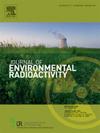U(VI) sorption onto rutile surface in the presence or absence of EDTA: A combined macroscopic and spectroscopic study
IF 1.9
3区 环境科学与生态学
Q3 ENVIRONMENTAL SCIENCES
引用次数: 0
Abstract
Knowledge of the sorption and speciation of uranium at mineral/water interface is essential to predict its long-term behavior. The sorption of uranium on minerals is well known affected by its interaction with EDTA. Here, the sorption of U(VI) on rutile in the presence or absence of EDTA was investigated by combining batch sorption, species calculation, time-resolved fluorescence spectroscopy (TRFS) and X-ray photoelectron spectroscopy (XPS). The batch sorption results suggest that the sorption of U(VI) on rutile is governed by outer-sphere surface complexation under acidic conditions, and undergoes a transformation to inner-sphere surface complexation as the pH increases. In the presence of EDTA, the sorption process is dominated by inner-sphere interactions across the entire pH range. EDTA has been observed to reduce the sorption of U(VI) on minerals, thereby enhancing the mobility of U(VI). Greater inhibition of U(VI) sorption was observed with increasing concentration of EDTA. The TRFS and XPS analysis reveal that the uranium presents as entirely distinct surface complexes on rutile in the presence or absence of EDTA. These findings are essential for understanding the sorption mechanism of U(VI) with EDTA at a molecular scale and developing a reliable assessment for the long-term storage of radioactive waste.
在EDTA存在或不存在的情况下,U(VI)在金红石表面的吸附:宏观和光谱相结合的研究
了解铀在矿物/水界面的吸附和形态对预测其长期行为至关重要。众所周知,铀在矿物上的吸附受其与EDTA的相互作用的影响。本研究采用间歇吸附、物种计算、时间分辨荧光光谱(TRFS)和x射线光电子能谱(XPS)相结合的方法,研究了EDTA存在或不存在时金红石对U(VI)的吸附。批量吸附结果表明,在酸性条件下,U(VI)在金红石上的吸附受外球表面络合作用的控制,随着pH的增加,U(VI)的吸附向内球表面络合作用转变。在EDTA存在的情况下,整个pH范围内的吸附过程主要由球内相互作用主导。EDTA可以减少矿物对U(VI)的吸附,从而提高U(VI)的迁移率。EDTA浓度越高,对U(VI)吸附的抑制作用越大。TRFS和XPS分析表明,在EDTA存在或不存在的情况下,铀在金红石上表现为完全不同的表面配合物。这些发现对于在分子尺度上理解EDTA对U(VI)的吸附机制以及对放射性废物的长期储存进行可靠的评估具有重要意义。
本文章由计算机程序翻译,如有差异,请以英文原文为准。
求助全文
约1分钟内获得全文
求助全文
来源期刊

Journal of environmental radioactivity
环境科学-环境科学
CiteScore
4.70
自引率
13.00%
发文量
209
审稿时长
73 days
期刊介绍:
The Journal of Environmental Radioactivity provides a coherent international forum for publication of original research or review papers on any aspect of the occurrence of radioactivity in natural systems.
Relevant subject areas range from applications of environmental radionuclides as mechanistic or timescale tracers of natural processes to assessments of the radioecological or radiological effects of ambient radioactivity. Papers deal with naturally occurring nuclides or with those created and released by man through nuclear weapons manufacture and testing, energy production, fuel-cycle technology, etc. Reports on radioactivity in the oceans, sediments, rivers, lakes, groundwaters, soils, atmosphere and all divisions of the biosphere are welcomed, but these should not simply be of a monitoring nature unless the data are particularly innovative.
 求助内容:
求助内容: 应助结果提醒方式:
应助结果提醒方式:


